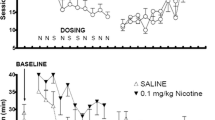Abstract
Spiroperidol, which blocks dopamine (DA) receptors, attenuated self-stimulation of the nucleus accumbens, septal area, hippocampus, anterior hypothalamus and ventral tegmental area. Dopamine is thus involved in self-stimulation of many sites (in addition to the lateral hypothalamus). The attenuation was not a simple motor impairment of the speed of bar-pressing in that the nucleus accumbens and septal self-stimulation rates were lower than those in treated animals self-stimulating at other sites (Experiment 1). Feeding was partly attenuated, and drinking was much less attenuated by the spiroperidol. Since the rats bar-pressed for brain-stimulation reward, chewed pellets to eat, and licked a tube to drink, dopamine-receptor blockade may attenuate complex motor responses most. Alternatively, the blockade could affect brain-stimulation reward more than the controls of eating, and these latter more than the controls of drinking (Experiment 2). In Experiment 3, feeding and drinking were equally and severely attenuated when rats had to bar-press to obtain food or water. The attenuation was to a level similar to that found for self-stimulation. These experiments suggest that dopamine receptor blockade impairs eating, drinking and self-stimulation by interfering with complex motor responses.
Similar content being viewed by others
References
Andén, N. E., Butcher, S. G., Corrodi, H., Fuxe, K., Ungerstedt, U.: Receptor activity and turnover of dopamine and noradrenaline after neuroleptics. Europ. J. Pharmacol. 11, 303–314 (1970)
Anlezark, G. M., Arbuthnott, G. W., Christie, J. E., Crow, T. J.: Electrical self-stimulation with electrodes in the region of the interpeduncular nucleus. J. Physiol. (Lond.) 234, 103 P (1973)
Costal, B., Naylor, R. J., Olley, J. E.: Catalepsy and circling behaviour after intracerebral injections of neuroleptic, cholinergic and anticholinergic agents into the caudate-putamen, globus pallidus and substantia nigra of rat brain. Neuropharmacol. 11, 645–663 (1972)
Crow, T. J.: A map of the rat mesencephalon for electrical self-stimulation. Brain Res. 36, 265–273 (1972)
Fuxe, K., Hokfelt, T., Ungerstedt, U.: Morphological and functional aspects of central monoamine neurons. Int. Rev. Neurobiol. 13, 93–126 (1970)
Hornykiewicz, O.: Dopamine in the basal ganglia. Brit. med. Bull. 29, 172–178 (1973)
Kelly, P. H., Rolls, E. T., Shaw, S. G.: Functions of catecholamines in brain-stimulation reward. Brain Res. 36, 363–364 (1974)
König, J. F. R., Klippel, R. A.: The Rat Brain. Baltimore: Williams and Wilkins (1963)
Oltmans, G. A., Harvey, J. A.: L. H. syndrome and brain catecholamine levels after lesions of the nigrostriatal bundle. Physiol. Behav. 8, 69–78 (1972)
Phillips, A. G., Fibiger, H. C.: Dopaminergic and noradrenergic substrates of positive reinforcement. Science 179, 573–576 (1973)
Rolls, E. T.: The neural basis of brain-stimulation reward. Progr. Neurobiol. 3 (in press, 1974)
Rolls, E. T., Kelly, P. H.: Neural basis of stimulus-bound locomotor activity in the rat. J. comp. physiol. Psychol. 81, 173–182 (1972)
Rolls, E. T., Kelly, P. H., Shaw, S. G.: Noradrenaline, dopamine, and brain-stimulation reward. Pharmac. Biochem. Behav. 2 (in press, 1974)
Sacks, O.: Awakenings. London: Duckworth 1973
Stark, P., Turk, J. A., Redman, C. E., Henderson, J. K.: Sensitivity and specificity of positive reinforcing areas to neurosedatives, antidepressants and stimulants. J. Pharmacol. exp. Ther. 166, 163–169 (1969)
Stein, L.: Psychopharmacological substrates of mental depression. In: Antidepressant Drugs. S. Garattini and M. N. G. Dukes, Eds., Int. Congress. Series, 122, pp. 130–140. Excerpta Med. Found. Amsterdam 1967
Stein, L., Ray, O. S.: Brain stimulation reward “thresholds” self-determined in rat. Psychopharmacologia (Berl.) 1, 251–256 (1960)
Ungerstedt, U.: Stereotaxic mapping of the monoamine pathways in the rat brain. Acta physiol. scand. Suppl. 367, 1–48 (1971a)
Ungerstedt, U.: Adipsia and aphagia after 6-Hydroxydopamine induced degeneration of the nigro-striatal dopamine system. Acta physiol. scand. Suppl. 367, 95–117 (1971b)
Wauquier, A., Niemegeers, C. J. E.: Intracranial self-stimulation in rats as a function of various stimulus parameters. II. Influence of haloperidol, pimozide and pipamperone on medial forebrain stimulation with monopolar electrodes. Psychopharmacologia (Berl.) 27, 191–202 (1972)
Author information
Authors and Affiliations
Additional information
This work was supported by the Medical Research Council.
Rights and permissions
About this article
Cite this article
Rolls, E.T., Rolls, B.J., Kelly, P.H. et al. The relative attenuation of self-stimulation, eating and drinking produced by dopamine-receptor blockade. Psychopharmacologia 38, 219–230 (1974). https://doi.org/10.1007/BF00421374
Received:
Revised:
Issue Date:
DOI: https://doi.org/10.1007/BF00421374




